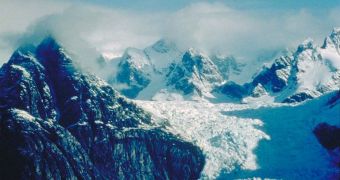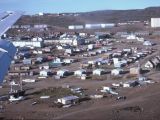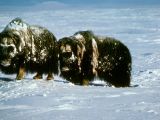On the first of April 1999 the most recent territory of Canada, Nunavut, came to existence.
Canada's map has changed for the first time after Newfoundland joined the confederation. Nunavut compasses one fifth of Canada's territory on the mainland, and is larger than any of Canada's provinces.
Nunavut's climate is arctic, with very cold winters and short summers that are too cool to permit the growth of trees. The temperatures are well below 0? C for most of the year, with only less than 250 mm of precipitation annually. Average monthly temperatures are below freezing for eight months of the year, that's why most of the territory is covered by tundra or arctic desert.
Here lives the youngest population of Canada, but it is also the least populated territory. 29,500 persons, of which 56 % are younger than 25, live in a territory much larger than Alaska's. 76 % are Inuit (Eskimos), 13 % Non-Indigenous and the rest Metis or Indians.
Nunavut means "our land" in the Inuktitut Eskimo language and emerged after the signing of an agreement between the Canadian federal government and the Inuits, about colonization and indigenous rights. The "father" of Nunavut is considered John Amagoalik, which managed to "build" it after 25 years of struggle.
The Inuits underline the differences, no matter how integrated they are in the life of modern Canada, and even changed the geographic names. Whale's Cove has become Tikirarjuaq, Frobisher Bay is already named Iqaluit, Rankin Inlet is now Kangiqting and so on.
They combine the new and the ancient, with extremely profound roots in an ancestral totemic world. Still, in the XIX century, the Christian missionaries finished with the Eskimo shamanism.
98 % of the Canadians will probably never set foot during their lifetime on this huge territory. The area, four times bigger than Texas, is so empty that a weather station built by the Germans during the Second World War was found just after 40 years, near Button Island.
Iqaluit ("in the place of the fish") is the capital of this vast zone and has 6,184 inhabitants. This settlement, located in the southeast of the Baffin Island, was founded in 1942 as American airbase and it is the most isolated "town" of Canada, at thousands of km from the larger cities of Canada and accessible only by aircraft and boat, when the sea is not frozen. A Navy base could be established in Iqaluit.
In 1979, the sole high school of this territory was functioning in Iqaluit. Today there are several public schools and nurseries, a community center, a firemen station and a large supermarket of the Hudson's Bay Co. Even today the city is a mix of Eskimo huts, modern houses, stores and official buildings.
This is the only settlement in Nunavut with night life, restaurants, clubs, cinemas, and bingo on Friday nights. Skating is popular and hockey too. Less than 60 % of the Iqaluit population is Eskimo.
Besides the Iqaluits, there are just other 28 isolated villages in all Nunavut, with a population of 85 % Eskimo. The European Canadians are named qallunaat ("people with big eyebrows and large belly") by the Eskimos.
The new capital is flourishing, and new private companies are constantly emerging. An important infrastructure receives actors and directors looking for Arctic landscapes for their movies.
Still, there are problems that the Nunavut population faces: alcoholism, high number of suicides and an enormous demographic growth: 40 % of the Indigenous population is under 15.
Some Indigenous still live in the traditional way, in igloos or seal/caribou skin tents. They have a nomad life, live on what they hunt and fish, besides receiving a small governmental subvention. Seal meat will feed both people and dogs, the skin is used for making suits and boots ("kamiit"), and the fat is used as oil for the lamps.
Seals are hunted through a hollow made in the ice using a trident ("kakivak") or harpoons, made of stone, wood or bone. Other hunted mammals include: caribou, walrus, beluga, polar bear, arctic fox, musk ox, narwhal, and whale. They consume also birds, like geese, ducks, ravens and, in case of food shortage, owls. From water, they extract clams, sculpins, snails, chars, crabs and shrimps.
The traditional suit reflects the hunting abilities of the owner and is made of skins of caribou, seal, polar bear, musk ox, arctic fox, rabbit, and wolverine, all adorned with bird plumage.
With the melting, in June, the nomads gather near Iqaluit, and the reunited families start a period of feasts and celebrations: they play, dance, sing at the rhythm of the traditional drum made of seal skin. In the rest of the year, they work in small groups of 2-3 families and only reunite for special works or choose a mate and set up matrimony.
In the Eskimo wedding, the guests sit down on the ground and eat raw caribou meat and char, cut with the traditional knife ("ulu"). From this tradition, the Algonquin Indians gave them the name western people know them (Eskimo means "raw meat eater" in Algonquin).
The Nunavut's official languages are English, French and Inuktitut. Today, the existence of Inuktitut is menaced by the English. Till the fourth level, the pupils receive a bilingual education, but after that all is in English. Traffic signs are bilingual.
On the island of Baffin, the oldest human settlements are 4,500 years old. The direct ancestors of the modern Inuits reached the place 1,000 years ago. From place to place, you can see "inuksuit", mysterious stone piles inhabited by ghosts, which signals routes or good places to hunt or fish.
The Eskimos of Nunavut also hunt polar bears. They receive annually 16 permits for hunting the white bears. They can be conceded to foreigners for $ 175,000, still only 5 have been given.
To overcome the subsistence economy, Nunavut has put great hopes on commercial fishing, craftwork, and tourism. The char reaches the San Francisco restaurants, and the caribou and musk ox meat the supermarkets of Boston. Shrimp industry is going to be developed, but also transport, and hotel business.
The Nunavut's rich deposits of gold, silver, lead, zinc, nickel, copper and diamonds will be exploited. Three national federal parks have been established. But there are many things still missing, especially asphalted roads, which are basic for the development.

 14 DAY TRIAL //
14 DAY TRIAL // 

